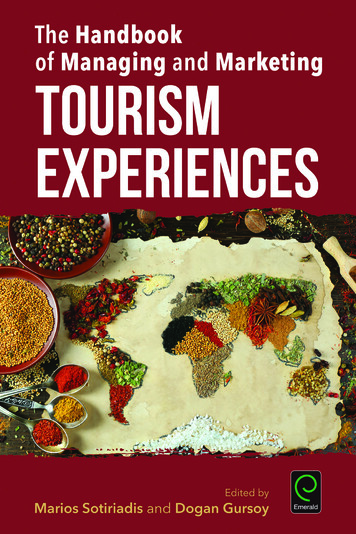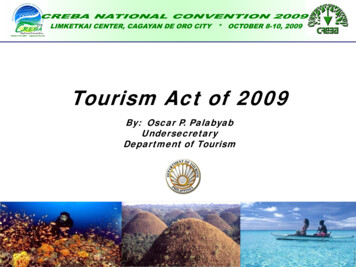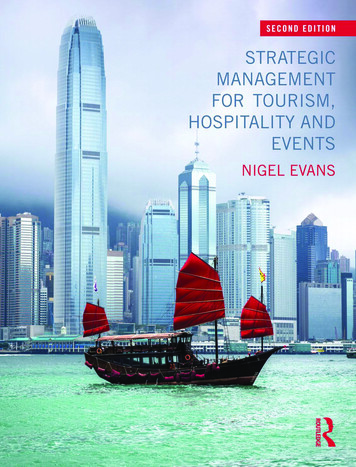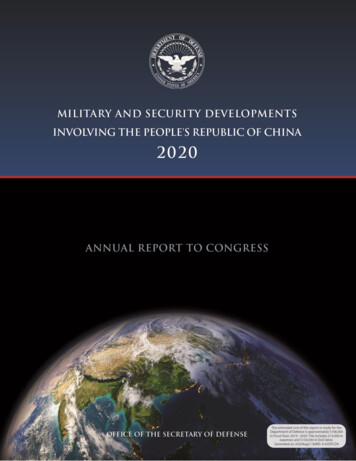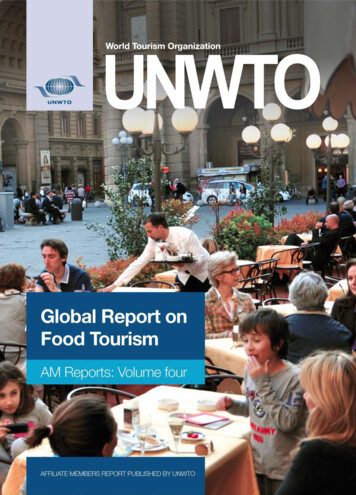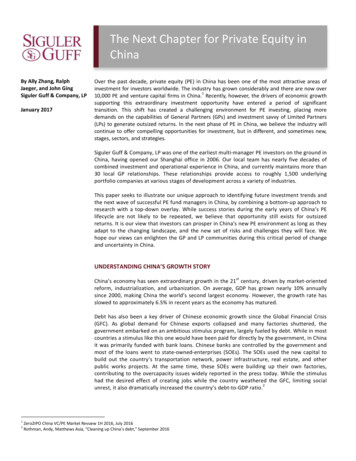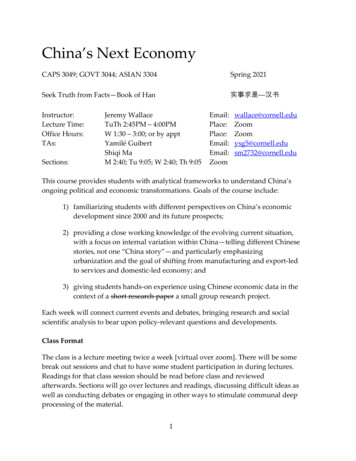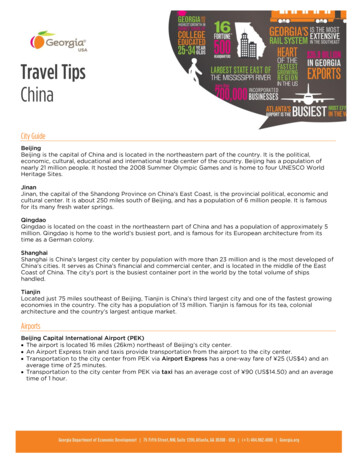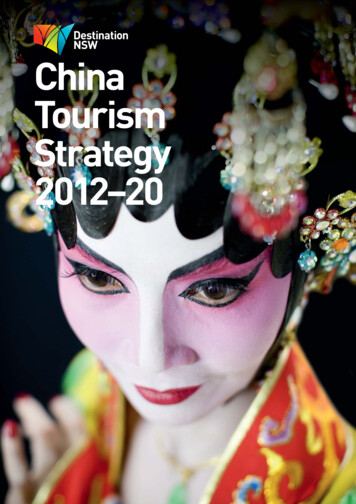
Transcription
ChinaTourismStrategy2012–20
FOREWORDThis document is designed to provide NewSouth Wales operators with a succinct snapshotof Destination NSW’s China Tourism Strategyand Action Plan.China has been much heralded as a tourismsource market for Australia and NSW has hadan active and successful presence in China formany years.However, changes in competition and marketdynamics, and the NSW Government’s goal todouble the value of overnight visitor expenditureto NSW by the year 2020, have highlighted theneed for expanded activities and new strategies.Destination NSW intends to capitalise on thediverse opportunities on offer in China. We willactively build new markets, support newproducts and services and develop our industrypartnerships to ensure that NSW securessubstantial market share and harnesses thepotential of the China market.Sandra ChipchaseChief Executive OfficerDestination NSWb 1
ChinaTourismStrategy2012–20
MINISTER’S MESSAGEIn this ‘Asian Century’, it is of critical importance that New South Wales (NSW) continues to increase tradeand investment links with China. The NSW Government has adopted a whole-of-government approach tothe market and is actively supporting key export industries in our quest to develop Chinese markets.Not surprisingly tourism is expected be among the state’s highest performing industries in terms ofdelivering growth.Tourism from China to NSW began its extraordinary rise when Australia received Approved DestinationStatus (ADS) in 1999. In recent years the acceleration in growth has been extraordinary and China is nowNSW’s largest international market in terms of expenditure, contributing more than 1.1 billion annually tothe NSW Visitor Economy.However China is a rapidly evolving tourism market, constantly throwing out challenges and opportunitiesto an intensely competitive global marketplace. Australia and its State and Territory partners now havemany competitors in China. If NSW is to protect its position it will need focus on this burgeoning marketin coming years.Sydney’s brand appeal in China is a prime motivator for travel to Australia and Destination NSW’s strategiesoperate on two levels; supporting the national marketing effort through continued promotion of Sydney; andensuring that NSW remains Australia’s market leader by continuing to attract the highest share of bothvisitor arrivals and visitor nights.Destination NSW has undertaken an extensive examination of the market and identified a series ofstrategic directions outlined in this document that will guide business development and marketinginitiatives between 2012–2020.Priority will be given to targeting additional geographic source markets within China and engaging the moremature FIT consumer segment. This will require considerable focus on extending the range of NSW productin market and improving the Chinese visitor experience in Sydney and Regional NSW.Strategic partnerships with public and private sector partners are also highlighted. Given the size andcomplexity of the market, a co-operative approach is essential. This approach will also extend to other NSWindustry sectors operating in China, with clear areas of alignment between tourism and the businessevents, education and investment sectors.If we are able to capitalise on the opportunities presented by China over the next decade, NSW visitorarrivals and visitor nights are expected to almost double. Over the ten-year period 2020/21 China willcontribute more than 17.4 billion to the NSW Visitor Economy and be directly responsible for 13,900 jobs.We have set an ambitious agenda for China and the stakes are very high. However I am confident that withthe support of our Government, the industry and their commercial partners will achieve great success.George Souris MPMinister for Tourism, Major Events,Hospitality and Racing, andMinister for the Arts22 3Destination New South Wales
CONTENTSChina Tourism Strategy02Minister’s Message03Contents04Executive Summary06NSW and the China Market to Australia08NSW Visitor Forecasts09Strategic Directions11Geographic Source Markets14Aviation16Consumer Segments19Visitor Experiences22Consumer Promotion24Trade Distribution28Government and Commercial Partnerships30Resources
EXECUTIVE SUMMARYDestination NSW’s China Tourism Strategy willguide business development and consumermarketing activity between 2012–2020. Thestrategy is directed towards ensuring that NSWkeeps pace with the rapid expansion ofgeographic source markets within China and thechanging travel preferences of maturingconsumer segments.A key objective of the strategy is to protect NSW’sleadership position. While the China market iscontinuing to grow, so too is the competitor threatfrom other destinations. NSW currently attracts60 per cent of all Chinese visitors to Australia and40 per cent of Chinese visitor nights.Forecasts indicate that if the state is successful inprotecting its market share, the value of Chineseinbound tourism to NSW will almost double. By2020 China will be NSW’s largest internationalmarket in terms of visitor arrivals, visitor nights andexpenditure; it will contribute more than 2.1 billionin expenditure annually to the NSW Visitor Economy;and be directly responsible for 13,900 jobs.The strategy is directed towardsensuring that NSW keeps pace withthe rapid expansion of geographicsource markets within China andthe changing travel preferences ofmaturing consumer segments.Securing additional air servicesfrom China is important butimproving load factors will beessential. Airline and industrypartnerships are key to ensuringsustainable and significant growth.4 5Destination New South Wales
STRATEGIC DIRECTIONSTo capitalise on opportunities presented by Chinaover the next decade Destination NSW has identifiedeight strategic directions:1. Extend Marketing Activity into more2.3.4.5.6.7.8.Geographic Source MarketsSupport Aviation and Route Development toKeep Pace with DemandTarget High Performing Consumer SegmentsImprove the Quality and Range of VisitorExperiencesIncrease Consumer PromotionDevelop Trade Distribution NetworksExpand Commercial and GovernmentPartnershipsIncrease Resources to Facilitate Growth.Sydney with its unique balance of city and natureexperiences will be the focus for destinationpromotion in China. Regional destinations within threehours drive of Sydney, and North Coast regionsaccessible from the Gold Coast will also be supported.Central to Destination NSW’s approach is thetargeting of high performing consumer segmentsand the phased development of up to 30 new‘secondary city’ source markets, which will beserviced from four major hubs: Beijing (North),Greater Shanghai (East), Guangdong province(South) and the new, rapidly growing CentralWestern sector of Chengdu/Chongqing.To encourage additional aviation services to keeppace with projected travel demand, DestinationNSW will adopt a multi-airline developmentapproach. Priority will be given to building capacityinto Sydney from primary city hubs and supportingthe establishment of direct routes from other majorChinese cities.Destination NSW has targeted several keyconsumer segments for growth from these regions.While Approved Destination Status (ADS) grouptravel will remain a primary target, considerableemphasis will also be given to engaging with theemerging FIT segment.Other key segments include Business Events Traveland Student Travel – both are strategicallyimportant because of their links with other NSWexport industries.China Tourism StrategyDestination NSW will work co-operatively withgovernment and private sector organisations toengage these markets.NSW’s range of product in-market requiresexpansion and enhancement to meet the needs ofthe more sophisticated and experienced FIT visitor.Product development and trade distributionactivities will be stepped up in partnership withindustry. The aim is to bring new categories ofrelevant product to market such as Resort Stays,Wedding/Honeymoon, Food and Wine, UniqueEvents, Luxury and Soft Adventure and buildexisting segments such as Self Drive and Golf.The focus on product development further extends toensuring that Sydney and Regional NSW better meetthe needs of Chinese visitors. A priority will be towork with industry and government agencies toimprove the quality of the Chinese visitor experience.Programs will include increasing the availability oftrained Mandarin speaking guides; providing betterChinese language information resources andsignage; and addressing issues associated withvisitor shopping and dining experiences.Destination NSW has also highlighted the importanceof trade distribution in the strategy. Provision hasbeen made to increase trade servicing activitiesthroughout China. Additional support will also beprovided to NSW tourism operators to encourageentry to the market – programs will includeeducational activities, incentives for operators tobecome ‘China Ready’ and coordination of tradeshow participation and workshops in-market.Destination NSW’s consumer marketing activity willbe directed primarily to the FIT segment and willaim to build consumer awareness and aspiration tovisit Sydney. Marketing activity will be largelyconducted through digital channels supported byextensive publicity programs. Partnershipmarketing activity will include support for TourismAustralia’s consumer campaigns, retail campaignsconducted with trade partners, and co-operativepromotions undertaken with commercial partners.In response to the expansion of the market,Destination NSW will allocate additional resourcesto facilitate growth. The majority of these will befocused on business and trade developmentactivities. Additional resources will be madeavailable to improve in-market Public Relations anddigital marketing capability.
NSW AND THE CHINA INBOUND TOURISM MARKETTO AUSTRALIA5004003002001001YE March 2010YE March 2011YE March 2012YE March 2011YE March 2012YE March 2009YE March 2008YE March 2007YE March 2006YE March 2005YE March 2004YE March 2003YE March 2002Source: IVS, YE March 2012 TRA30000250002000015000100005000YE March 2009YE March 2008YE March 2007YE March 2006YE March 20050YE March 2004However, while the outlook for the market is buoyantsignificant changes to consumer travel preferences;geographic source markets within China; tradedistribution; direct airline services to other states;and the escalation of competitor threat means thatNSW needs a new strategy if it is to reach the goal ofdoubling overnight visitor expenditure by 2020.CHINESE VISITOR NIGHTS –AUSTRALIA AND NSW SINCE 2000YE March 2003NSW is now Australia’s market leader, with a60 per cent market share of Chinese visitor arrivalsand a 40 per cent share of visitor nights. Over thelast decade, despite shocks such as terrorismattacks, international pandemics and the globalfinancial crisis, Chinese annual visitor arrivals andvisitor nights have continued to climb on animpressive trajectory of growth. Australia Visitors (‘000) New South Wales Visitors (‘000)YE March 2002Since 2000, New South Wales has captured themomentum of the market – benefiting fromSydney’s global appeal, its position as the majorgateway for Chinese visitors and its ‘first mover’status – a principal destination for most first timevisitors to Australia. NSW’s servicing of the market,which began in the late 90s has been a strength insecuring trade support from China.YE March 2010Forecasts for 2020 indicate that the inbound marketfrom China is set to more than double in size,contributing more than one million visitors toAustralia and more than 6.8 billion in TotalInbound Economic Value.1YE March 20010YE March 2001Despite an initial concentration into Sydney,Melbourne and Brisbane, Chinese visitors are alsostarting to travel further afield and the market nowranks impressively as Australia’s third largest fordispersed nights.Source: IVS, YE March 2012 TRA600YE March 2000Since 2000 there has been rapid growth in tourismfrom China – it is now ranked amongst Australia’sfastest growing and highest yielding visitor markets.It outperforms all other markets in terms of lengthof stay and is richly diverse, performing well acrossHoliday, Visiting Friends and Relatives (VFR),Business and Education travel segments.CHINESE VISITOR ARRIVALS –AUSTRALIA AND NSW SINCE 2000YE March 2000In 1999 Australia became one of the first Westerncountries in the world to be granted ApprovedDestination Status (ADS) by the ChineseGovernment. This was a significant breakthroughfor the Australian tourism industry; it effectivelygave the green light for the opening up ofMainland China as a source market for inboundvisitors and delivered an early entry advantage toa market of unparalleled promise. Australia Visitor nights (‘000) New South Wales Visitor nights (‘000)Source: TFC Forecast 2012 Issue 16 7Destination New South Wales
TOURISM SNAPSHOT:CHINESE VISITORS TO NSW YEAR ENDING MARCH 2012CHINESE VISITOR ARRIVALSPURPOSE OF VISITAustralia530,000NSW320,000Growth on Previous Year: Australia 15%Growth on Previous Year: NSW 10%NSW Market Share Visitors:60% of Chinese inbound market to AustraliaVisitorsHoliday63%10%Visiting friends EmploymentVISITOR NIGHTSOtherAustralia25.6 million NSW10.2 million Growth on Previous Year: Australia 2%Growth on Previous Year: NSW–1%NSW Market Share Nights:40%Total1%0%100%100%PURPOSE OF VISIT –CHANGES ON PREVIOUS YEAR (YE MAR 2011)VisitorsAVERAGE LENGTH OF STAYAustraliaVisitors% chg onprevious year48.4 nights*NSW32 nights**includes student visitorsEXPENDITURETotal Australia 2.7 billionTotal NSW 1.1 billionGrowth on Previous Year: Australia 8%Growth on Previous Year: NSW 5%Holiday201,40023%Visiting friends isitorNights% chg onprevious yearHoliday1,035,70048%Visiting friends 800223%22,800-92%10,235,700-1%TotalVISITOR DISPERSALVisitor NightsVisitation to Sydney and Regional NSWVisitorsVisitor nights97%91%7%9%SydneyRegional NSWNOTE: figures add to more than 100% due to multipledestinations applying to some visitorsTotal Number of Visitors and Visitor NightsVisitors % chgSydneyRegionalNSWNew SouthWalesBusinessVisitor nights % 0%10,235,700-1%NOTE: NSW total is less than addition of Sydney and RegionalNSW due to multiple destinations applying to some visitorsChina Tourism StrategyVisitor NightsEducationEmploymentOtherTotalSOURCE: All figures are sourced from the International VisitorSurvey YE March 2012, Tourism Research Australia
THE CHINA MARKETNSW’S 2020/21 FORECASTSThe Tourism Forecasting Council predicts thatMainland China will continue its current growthtrend for at least the next decade.National arrival forecasts for 2020/21 have beenrevised upwards to 1.039 million and visitor nightsto more than 48.9 million. Total economic value toAustralia from China is forecast to exceed 6.8 billion.2A key outcome for NSW in the years leading up to2020 will be to maintain market leadership byprotecting and growing its share of visitors andvisitor nights and continuing to attract higher levelsof expenditure.If NSW is successful in achieving this objective, it isset to almost double the value of Chinese visitorexpenditure* within the state by 2020/21. The tablebelow outlines 2020/21 forecasts for NSW, whichare based on current TRA Forecasts to 2020/21.2020/21 CHINA MARKET FORECASTS:Impacts NSW Visitors, Expenditure, Employment and Gross State Product.3INBOUND VISITORS FROM MAINLAND CHINANSW FORECASTS 2020/21Chinese visitor arrivals623,000Visitor nights19.6 millionEconomic Contribution*Visitor expenditure 2.1 billion*Gross State Product (GSP) 2.1 billion*Total contribution to GSP over the ten fiscal years between2011/12 to 2020/21 17.4 billion*EmploymentNumber of direct jobs13,900Number of direct and indirect jobs24,100* Measured in December 2011 Australian Dollars2Source: TFC Forecast 2012 Issue 13NSW Forecasts are estimates based on TFC Forecasts 2012Issue 1, Tourism Satellite Accounts and International VisitorSurvey, Tourism Research Australia8 9Destination New South Wales
Strategic DirectionsIf NSW protects and maintains its market share of visitors and visitor nights, Chinawill contribute more than 17.4 billion to the NSW economy over the ten-year periodto 2020/21 and be directly responsible for 13,900 jobs.Destination NSW has identified eight strategic directions in its Business DevelopmentStrategy for China to ensure that NSW is able to fully capitalise on the opportunitiespresented by China in the next decade. The strategic response to these priorities willrequire commitment and involvement from a broad range of industry, Governmentand corporate partners.1Extend Marketing Activity into more Geographic Source Markets2Support Aviation and Route Development to Keep Pace with Demand3Target High Performing Consumer Segments4Improve the Quality and Range of Visitor Experiences5Increase Consumer Promotion6Develop Trade Distribution Networks7Expand Commercial and Government Partnerships8Increase Resources to Facilitate GrowthChina Tourism Strategy
Central toDestination NSW’sapproach is thephased developmentof ‘secondary city’source markets.10 11Destination New South Wales
STRATEGIC DIRECTION 1EXTEND MARKETING ACTIVITIES INTO MOREGEOGRAPHIC SOURCE MARKETS 2012–2020Tourism Australia has undertaken an evidencebased market assessment of more than 600 citiesin China that identified the cities most likely to bepotential source markets for Australia in 2020.It concluded that in the next decade up to 55 citieswould have significant populations with the financialmeans and access to travel internationally. Whileprimary regions/cities will remain criticallyimportant, ‘secondary cities’ will drive tourismgrowth to Australia in the years leading up to 2020.KEY PRIORITIES Servicing Secondary Cities via Regional HubsAlthough 55 cities seems an extraordinary numberof markets to attempt to leverage, TourismAustralia suggests that economies of scale can beachieved by focusing marketing resources in fourprimary hubs: Greater Beijing (North), GreaterShanghai (East), Guangdong province (South) andthe new, rapidly growing Central Western sectorof Chengdu/Chongqing.Destination NSW will therefore increase itsin-market resources in these major hubs in order toadequately service the market. Destination NSW’sChina headquarters are in Shanghai. Phased DevelopmentDestination NSW will be taking a phased approachto market development – stepping up tradeand consumer activity as each market reachesappropriate milestones in size, maturity andvisitation levels.Marketing and resource commitments will bealigned to the differing levels of market maturity.Given Sydney’s ‘first mover’ appeal it is logical forNSW to align its development approach withTourism Australia’s. The table on page 13 indicatesproposed target markets and their anticipated stageof development in the years leading up to 2020.STRATEGIES: GEOGRAPHIC SOURCE MARKETSDesiredOutcomeNSW attracts the majority of visitors and visitor nights from China’s growinggeographic source markets.StrategyFocus marketing and development activity on primary tourism hubs withinEastern, Southern, Northern and Central /Western China.Activities In Developed Markets implement integrated trade and consumer marketing activitiesStrategyProvide consumer marketing and trade development services from primary hubsto secondary cities identified in Tourism Australia’s Market Prioritisation Plan.Activities Phased development of up to 30 city markets via a tiered development approach aimedat progressing markets through emerging and growth phases to maturity In Emerging Markets: Travel agent education through the Aussie Specialist program andassistance with market development In Growth Markets: Trade education, sales development, retail campaigns with PremierAussie Specialist agencies and consumer PRChina Tourism Strategy
CHINA GEOGRAPHICSOURCE gguan XiamenGuangzhouHuizhouShenzhenNorthern MarketsEastern MarketsSouthern MarketsCentral / Western Markets12 13Destination New South Wales
NSW’S CITY TARGET MARKETS BY GEOGRAPHIC REGION.Indicates how city markets will evolve through emerging and growth phases towards marketmaturity between 2012–20*REGIONNorthern MarketsPhase 1 (2012–14)Phase 2 (2014–17)Phase 3 (2017–20)Developed (Hub)BeijingBeijingBeijingGrowth nShenyangJinanPost 2014 Dalian, Shenyanand Jinan have enteredthe growth phaseEastern MarketsPhase 1 (2012–14)Phase 2 (2014–17)Phase 3 (2017–20)Developed uNanjingNingboSuzhouWuxiWenzhouEmerging MarketsWenzhouWuxiWenzhouPost 2017 Wenzhou hasentered the growth phaseSouthern MarketsPhase 1 (2012–14)Phase 2 (2014–17)Phase 3 (2017–20)Developed (Hub)GuangzhouGuangzhouGuangzhouGrowth henzhenXiamenDongguanFoshanHuizhouFuzhouEmerging t 2017 Huizhou andFuzhou have entered thegrowth phaseCentral / WesternMarketsPhase 1 (2012–14)Phase 2 (2014–17)Phase 3 (2017–20)Post 2020Chengdu/ChongqingDeveloped (Hub)Growth gqingChangshaWuhanEmerging MarketsNew markets willbegin to emerge in2014ChangshaWuhan5–6 additional Markets* Targets reflect alignment with Tourism Australia’s proposed city prioritisation approach leading up to 2020.In Developed Hubs: NSW undertakes integrated trade and consumer marketingFor Cities in the Growth phase: NSW’s focus is trade and market developmentFor Cities in the Emerging phase: NSW’s focus is trade education and some market development assistanceChina Tourism Strategy
STRATEGIC DIRECTION 2SUPPORT AVIATION & ROUTE DEVELOPMENTTO KEEP PACE WITH DEMANDIf 2020 visitor forecasts and the NSWGovernment’s goal of doubling visitorexpenditure are to be realised, China-Australiaroutes are going to require more aircraft, moreservices from primary markets and more directand indirect services from second-tier cities.Sydney as the premium gateway to Australia, isserviced by Chinese carriers, other Asian airlinesand Qantas. Recent bi-lateral agreements haveresulted in significant capacity increases for existingcarriers – but more is required.NSW faces many complexities in building airlinerelationships and capacity from China over comingyears and its strategies will need to be based on amulti-airline development approach. This meansDestination NSW will continue to maintain activerelationships and co-operative marketinginvestment with all carriers servicing NSW routesand gateways. In addition, the organisation mayneed to assist new and existing carriers in theirefforts to sustain capacity levels by buildingtwo-way traffic.Continued collaboration between Destination NSWand Tourism Australia will be essential; NSW needsto be able to leverage Tourism Australia’srelationships in market and also to potentially tapinto opportunities for financial support from theorganisation’s Aviation Development Fund.KEY PRIORITIES Building Capacity from Primary MarketsPriority will be given to ensuring sufficientcapacity to meet current increases in demandfrom the three primary hubs of Beijing, Shanghaiand Guangzhou. Route DevelopmentA second priority is to encourage direct capacityinto Sydney from other major Chinese cities.Destination NSW, in co-operation with SydneyAirport Corporation, will need to concentrateon further development of strategies whichprove viability of new services or open up newdestinations. A good example of this type ofstrategy is to provide support for charter services.CHINA SYDNEY FLIGHTSSydney has 39 flights per week from China4 but capacity will need to increase dramatically if visitorforecasts for 2020 are to be realised.Due to recent agreements between the Australian and Chinese Governments there are no regulatoryimpediments for airlines to increase services and capacity to Australia in the short to medium term.Services include:China SouthernChina Eastern14 services7 servicesAir ChinaQantas11 services7 servicesIn mid-2012 low cost carrier Scoot Airlines is also scheduled to introduce services between Tianjinand secondary city ports in China and Sydney via Singapore. Hainan Airlines may soon recommenceservices to Sydney.Airfares on the Australia-China route are relatively competitive compared to other long haul destinations.4As of March 201214 15Destination New South Wales
STRATEGIES: AVIATIONDesiredOutcomeAirline capacity from China to Sydney supports and stimulates growth from primary hubsand secondary cities.StrategyContinue to pursue a multi-airline development approach, with tiered level support formarketing based on current and committed capacity, frequency and routes.Activities Dedicate resources to developing co-operative partnerships under MOU agreements withairline partnersStrategyEncourage additional capacity from primary markets of Beijing, Shanghai and Guangzhou.Activities Collaborate with Sydney Airport Corporation and Tourism Australia in encouragingexisting carriers to add additional services on Sydney routesStrategyEncourage direct capacity from secondary cities.Activities Engage with new airline partners including third country and low cost carriersStrategyInvest in route development activities.Activities Increase investment in co-operative marketing with airline partners Assist sustainability of services by working in partnership with Sydney AirportCorporation to target the Sydney-based management of Chinese carriers and Qantas toprovide contacts and assistance that can help them build the two-way traffic Seek opportunities to obtain additional financial investment for aviation opportunitiesthrough Tourism Australia’s Aviation Development Fund Work with industry partners to support charter services from developing marketsChina Tourism Strategy
STRATEGIC DIRECTION 3TARGET HIGH PERFORMING CONSUMER SEGMENTS Consumer Segments in the China market areincreasingly differentiated by region and travelmaturity. Most Chinese leisure travel to NSW isnow (and in the foreseeable future) via ADS grouptravel. However it is strategically important thatNSW ensures that other segments are alsoprioritised for development. KEY SEGMENTS ADS Group TravelOver the next decade holiday travel to NSW willremain largely dominated by ADS Group Travel.Much of this segment will be sourced fromrapidly expanding markets in secondary cities.It is essential that NSW protect its market shareby extending its product development, trademarketing and consumer awareness activitiesbeyond its existing base in the primary cities. Assisted FIT ToursThere is a general consensus amongst the industryin both China and Australia, that NSW also needsto take advantage of the maturing travel marketsin Beijing, Shanghai and Guangzhou. Consumertravel preferences in these markets are rapidlyevolving and there is a major trend towardsFIT travel.Because of its leadership position in the marketNSW has the potential to position itself stronglyto FIT visitors – but it is quite vulnerable tocompetitive pressures from other statedestinations. If NSW is to successfully tap thisgrowing segment considerable effort has to bemade to address product development issues,and bring experiences to market such as SelfDrive, Golfing, Resort, Food and Wine, UniqueEvents, Luxury and Soft Adventure.5Student TravelAnother important segment for NSW is StudentTravel. NSW’s share of visitor nights is largelydriven by this segment (accounting for around 57%of visitor nights)5 and its associated VFR traffic.It is a strategically important segment, whichimpacts the wider NSW economy and is vital tomaintaining NSW’s share of visitor nights in 2020.Business Events TravelAlthough Business Events travel from China iscurrently quite low in volume it is extremely highyielding. A priority for NSW is to grow incentiveand convention business from China. NSW’sexport industries with China offer good leverageopportunities to support growth in thistravel segment.OTHER OPPORTUNITIESIn addition to these primary consumer segments,NSW has strong potential to develop a series of highyielding niche markets from different regions ofChina. They are evidence of the evolving nature ofthe market, which is showing increased diversity inconsumer travel preferences. These include LuxuryTravel and Special Interest or Affinity Travel – andare sourced from mature markets located inprimary cities. Government driven, industry basedTechnical Visits will also continue be a strongfeature of the market.Source: IVS YE March 201216 17Destination New South Wales
PRIMARY SEGMENTADS Group TravellerCharacteristics Opportunity Will remain a primary market for NSW in the next decade because of the state’sadvantage as a ‘first mover’ destination, driven by Sydney’s appeal Offers good potential for growth as more and more cities in mainland China expandtheir middle classes Will require more resources to service travel agents and wholesalers in up to30 potential city markets by 2020New or less experienced travellersPart of growing middle classTravels in groups of up to 20 peopleLittle or no EnglishSlightly more likely to be femaleGroup market is more susceptible to external shocks such as pandemics, terrorism etc.99 per cent use packaged arrangements purchased through travel agents/wholesalersVisit up to three destinations per tripHighly price sensitiveQuality issues prevalent with ‘below cost’ tours potentially affecting visitor satisfactionAssisted FIT TravellersChara
guide business development and consumer marketing activity between 2012–2020. The strategy is directed towards ensuring that NSW keeps pace with the rapid expansion of geographic source markets within China and the changing travel preferences of maturing consumer segments. A key objective
